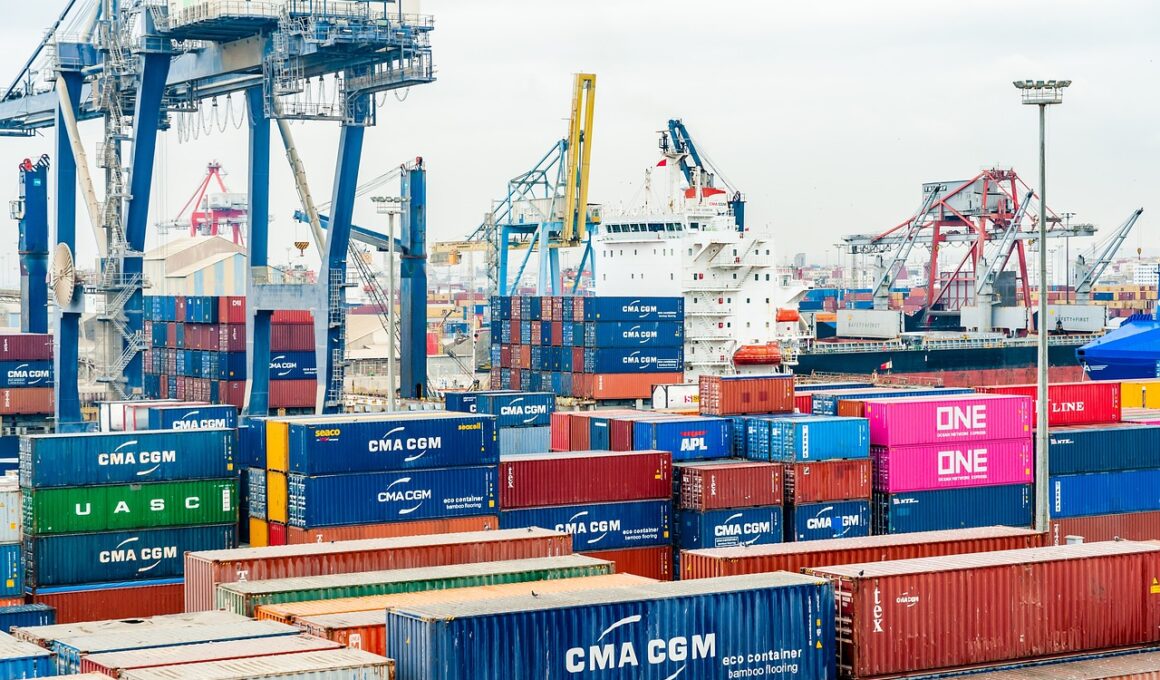Using Import and Export Price Data to Forecast Economic Growth
Import and export price data serves as a vital tool for economists and analysts, offering insights into economic trends and potential growth trajectories. Such data provides a clear view of market demand and supply dynamics, influencing domestic industries and the overall economic environment. By examining fluctuations in these prices, stakeholders can gain valuable knowledge about inflation rates and currency stability. Furthermore, import and export prices reflect the competitiveness of a country’s goods in the global market. When prices for imports rise, it may indicate increasing demand for foreign products, while falling export prices often suggest weaker international demand. Analyzing price changes also aids businesses in making informed decisions about production and pricing strategies. Economists often utilize trends in import and export prices to predict GDP growth and other key economic indicators. As economic conditions evolve, these data points help apprehend shifts in consumer behavior, trade balances, and market conditions. Understanding these elements is crucial for policymakers and businesses to strategize and adapt to the changing landscape of global trade.
The Link Between Import Prices and Economic Activity
Monitoring import prices provides valuable information for predicting economic activity levels. Fluctuating import prices often correlate with changes in domestic consumer demand and economic expansion. When import prices increase, it may suggest heightened demand for foreign goods. In contrast, lower import prices generally reflect reduced demand, signaling potential economic slowing. Consequently, businesses must adapt to these fluctuations by adjusting inventory and production strategies accordingly. Import prices also impact inflation rates. Rising import prices can contribute to overall inflation, prompting central banks to consider monetary policy adjustments to counteract inflationary pressures. Moreover, businesses often rely on imported materials and goods, directly impacting their production costs and, ultimately, pricing for consumers. Analyzing import prices allows analysts to assess the potential effects of exchange rate fluctuations on purchasing power. Changes in currency value can significantly affect import prices, thereby influencing consumer spending and economic behavior. Such connections highlight the importance of monitoring import price data in forecasting future economic conditions. In essence, understanding import price movements is essential for investors, policymakers, and businesses alike to make informed decisions.
The role of export prices in shaping economic forecasts cannot be underestimated. A decline in export prices often indicates a decrease in demand for a country’s goods abroad, which can lead to slowed economic growth. On the other hand, increasing export prices usually suggest stronger foreign demand, fostering positive economic sentiment and encouraging investment. The relationship between export prices and trade balances is also crucial, as altered prices can either enhance or diminish export profitability. An increase in export prices could improve trade balances, leading to a stronger currency, while reducing import expenses. Additionally, changes in export prices can directly influence domestic industries reliant on global markets, affecting their growth strategies and market positioning. Investors keep a close watch on export price trends to gauge market potential and economic stability. In particular, exporting nations should be attuned to global price fluctuations and their impacts on export volumes. This highlights the importance of understanding how export prices play a role in larger economic systems, providing insights that can guide economic policy and corporate strategy. Recognizing trends in exports and pricing is essential for businesses aiming to navigate globalization.
Utilizing Price Data to Anticipate Inflation Trends
Price fluctuations in imports and exports hold significant implications for inflation prediction. Economists often rely on this data to gauge inflationary pressures and to adjust forecasts accordingly. A surge in import prices is frequently indicative of potential inflation, as higher costs may be passed onto consumers. Conversely, declining import prices can signal lower inflation or deflation risks, particularly in economies reliant on imported goods. Similarly, export prices have their own inflationary consequences; increasing export prices suggest heightened demand can lead suppliers to raise domestic prices. Therefore, understanding the interplay between import/export prices and inflation is essential during economic analysis. By tracking these trends, policymakers can make informed decisions on interest rates to stabilize economic conditions. Furthermore, businesses can calibrate pricing strategies based on anticipated inflation trends emerging from this data. For effective economic planning, operating within an informed context of inflation forecasts helps ensure long-term sustainable growth. Analysts continuously evaluate changes in import/export prices to discern the broader picture influencing consumer behavior and economic health. This sophisticated analysis ultimately drives better economic policymaking and tactical business responses.
Economic growth forecasts rely heavily on import and export dynamics; they offer key insights that influence national policies and business strategies. When examining these indicators, economists evaluate trade balances, currency stability, and market competitiveness. Import and export prices can indicate shifts in demand and supply that directly impact GDP and economic outputs. Fluctuations in these prices are often signals for domestic industries, conjuring decisions regarding capital investment and resource allocation. Understanding the nuances behind these trends can empower companies to maximize profitability through well-timed adjustments to their production strategies. Additionally, analyzing trends in these prices can provide guidance for monetary policy. Central banks carefully consider import and export statistics as part of their overall assessments of economic health. As countries aim to boost their economic standings, the measurement of these trade prices becomes paramount. Stakeholders in the global market are intricately linked, necessitating constant vigilance of price movements. In short, import and export price data help shape economic narratives while offering invaluable foresight into the economic climate. This knowledge enables businesses and policymakers alike to navigate complexities within rapidly changing global markets.
Conclusion: Importance of Data Analysis in Forecasting
Analyzing import and export price data is critical for forecasting economic growth effectively. By placing value on the relationship between these prices and economic indicators like inflation and GDP growth, stakeholders can obtain a clearer picture of market conditions. Through data interpretation, businesses identify potential risks and opportunities, allowing them to pivot strategies as necessary to enhance competitive positioning. Economists, too, depend on comprehensive price analysis to inform policy-making. The implications of these data trends extend beyond mere statistics; they shape investments, drive innovation, and steer industries towards sustainability. Moreover, the implications on trade balances illustrate how crucial a tailored approach is in addressing dynamic global challenges. By upholding the study of import and export prices, analysts can pave the way for better-informed decisions across the board. This ongoing analysis enhances overall economic understanding and fosters adaptability within fluctuating markets. As the global economic landscape continues to evolve, investing in accurate data analysis becomes imperative. Therefore, integrating import and export price data within economic models is essential for constructing reliable forecasts that can usher economic stability and growth.
Ultimately, the importance of tracking import and export price data cannot be overstated in the forecasting process. Understanding the underlying relationships between these prices and economic growth equips a diverse group of stakeholders with the knowledge needed to navigate the complexities of global trade. Policymakers, researchers, and business executives alike benefit from insightful predictions derived from effective data analysis. As economies strive to promote sustainable growth, particularly in an age characterized by rapid technological change and market volatility, having the right tools and insights is paramount. The ability to forecast economic conditions more accurately enhances business opportunities and guides strategic planning endeavors. Furthermore, keeping abreast of changes in import and export prices is essential to maintain a competitive edge on the global market stage. Organizations that prioritize data analytics regarding trade will benefit from appropriate risk management and resource allocation, keeping them agile during economic shifts. This comprehensive understanding ultimately reflects the power of informed decisions, impacting economic growth trajectories. As we look forward, ensuring that forecasting methodologies incorporate current and comprehensive price data will be crucial to establishing resilience in constantly evolving economic environments.


